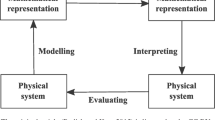Abstract
We study the interconnection between Physics and Mathematics in concrete instances, departing from the usual expression for the Coulomb electric field, produced by a point-like charge. It is scrutinized by means of six epistemology-intensive questions and radical answers are proposed, intended to widen one’s understanding of the subject. Our interventions act along two complementary directions. One of them regards ontology, since questions induce one to look closely at the electric charge, from different perspectives, promoting reflections about its nature and reinforcing the corresponding concept. Formal manipulations rely on the identification of concepts with symbols, and the other direction concerns the spatial extension of mathematical structures. Our questions and their somewhat unusual answers help disclosing information which is not present in many textbooks, and show that Mathematics can be used as an efficient epistemological tool in Physics teaching.

Similar content being viewed by others
Notes
Saci is pronounced Sah-see, the tonic syllable being the last one. The interested reader may find pictures and other information in the internet, under Saci Perere.
In a space with \(n\) dimensions, the surface of a sphere with radius \(r\) is given by \(S_n= r^{(n-1)}\; 2\, \pi ^{n/2}/\Gamma (n/2)\,\).
References
Bachelard, G. (1940). La philosophie du non. Paris: Presses Universitaires de France.
Bechara, M. J., Duarte, J. L. M., Robilotta, M. R., & Salém, S. (2014). Física 3 e Física 4, lecture notes, University of São Paulo.
Feynman, R. P. (1967). The character of physical law. Cambridge: The M.I.T Press.
Goldman, C., Lopes, E., & Robilotta, M.R. (1981). Um pouco de luz a lei de Gauss. Revista de Ensino de Física, v. 3, n.3.
Kuhn, T. S. (1962). The structure of scientific revolutions. International encyclopedia od unified science, v. 2, n.2. Chicago: The University of Chicago Press.
Machado, N. J. (2000). Educação: Projetos e Valores. São Paulo: Coleção Ensaios Transversais. Escrituras Editora.
Pietrocola, M. (2002). A Matemática como Estruturante do conhecimento físico. Caderno Brasileiro de Ensino de Física, 19(1), 93–114.
Redish, E.W., & Kuo, E. Language of physics, language of math: Disciplinary culture and dynamic epistemology, preprint, available at http://arxiv.org/abs/1409.6272.
Salém, S. (1986). Conceptual structures in Physics Teaching: an application to Electrostatics, M.Sc. thesis (Text in Portuguese), University of São Paulo, Brazil.
Skyrme, T. H. R. (1955). Meson theory and nuclear matter. Proceedings of the Royal Society of London, A230, 277–286.
Skyrme, T. H. R. (1958). A nonlinear theory of strong interactions. Proceedings of the Royal Society of London, A247, 260–278.
Skyrme, T. H. R. (1961). A nonlinear field theory. Proceedings of the Royal Society of London, A260, 127–138.
Skyrme, T. H. R. (1962). A unified field theory of Mesons and Baryons. Proceedings of the Royal Society of London, 31, 556–569.
Uhden, O., Karam, R., Pietrocola, M., & Pospiech, G. (2012). Modelling mathematical reasoning in physics education. Science & Education, 21, 485–506.
Zahed, I., & Brown, G. E. (1986). The Skyrme model. Physics Reports, 142, 1.
Acknowledgments
We would like to thank Ricardo Karam for inducing this paper and for continuous encouragement during its preparation.
Author information
Authors and Affiliations
Corresponding author
Rights and permissions
About this article
Cite this article
Kneubil, F.B., Robilotta, M.R. Physics Teaching: Mathematics as an Epistemological Tool. Sci & Educ 24, 645–660 (2015). https://doi.org/10.1007/s11191-014-9727-5
Published:
Issue Date:
DOI: https://doi.org/10.1007/s11191-014-9727-5




